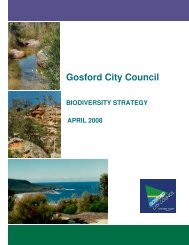Wamberal Cemetery Plan of Management - Gosford City Council
Wamberal Cemetery Plan of Management - Gosford City Council
Wamberal Cemetery Plan of Management - Gosford City Council
You also want an ePaper? Increase the reach of your titles
YUMPU automatically turns print PDFs into web optimized ePapers that Google loves.
• Monument <strong>of</strong> special interest include:<br />
- Original ANZAC Jack Christie – 18/10/1964<br />
- To the families <strong>of</strong> Gleeson, Swadling, Christie, Smith, Ward, Brooks, Scott, Towell, Whitehead<br />
and Nunn.<br />
- Yim Cheung Wong 1986 – only Asian monument at 1991.<br />
- Another is the only Greek inscription to a Scotsman, David Grace.<br />
• The fact that <strong>Wamberal</strong> wasn’t opened until 1861 suggests little local organised settlement before<br />
then. Borne out in inscriptions referring to ‘pioneers” during the period 1900-1930.<br />
• Significant increases in burials each decade after 1930. There are mainly Anglo-Saxon and few<br />
Roman Catholic burials.<br />
• The majority <strong>of</strong> headstones are modest, reflecting socio-economic pr<strong>of</strong>ile.<br />
• <strong>Wamberal</strong> <strong>Cemetery</strong> is a valuable historical resource and should be maintained as a monument to the<br />
people <strong>of</strong> the area.<br />
• The largest number <strong>of</strong> burials are in the Lawn <strong>Cemetery</strong> section, opened in 1970.<br />
• Most burials are Church <strong>of</strong> England and the war periods are reflected in increased male graves.<br />
The following information is drawn principally from the publication “Six Brisbane Water Cemeteries. A<br />
Heritage Tour: by Jillian Baxter and supplemented by the <strong>Cemetery</strong> Survey undertaken in 1991 by Anne<br />
Jordan.<br />
The <strong>Cemetery</strong> was drawn up on Survey September 1880. The <strong>Plan</strong> <strong>of</strong> Survey provided for the <strong>Cemetery</strong> to<br />
be divided into the following sections: Church <strong>of</strong> England, Roman Catholic, Wesleyan, Presbyterian,<br />
Independent and General.<br />
The fact that the <strong>Cemetery</strong> was not dedicated and opened before 1881, suggests little local organised<br />
settlement before then. This is borne out in inscriptions referring to the deceased having been local are<br />
“pioneers” during the first few decades <strong>of</strong> the 20 th Century.<br />
The trend obviously continued until as late as the end <strong>of</strong> the 1960’s, because the largest number <strong>of</strong> burials in<br />
the <strong>Cemetery</strong>, are in the Lawn <strong>Cemetery</strong> section, operational only after 1970. However, compared with the<br />
very early years, there were significant increases in burials each decade after 1930, mainly <strong>of</strong> Anglo-Saxons<br />
(Protestants) and few Roman Catholics.<br />
Most burials are <strong>of</strong> Church <strong>of</strong> England people and the war periods 1914-1918 and 1939- 1945 are reflected<br />
in increased male graves during those periods. The majority <strong>of</strong> headstone were (and remain) modest,<br />
accurately reflecting the socio-economic pr<strong>of</strong>ile <strong>of</strong> the area.<br />
The <strong>Cemetery</strong> was dedicated the following year, but the earliest burial occurred in 1888. The exact location<br />
<strong>of</strong> the first grave is not known but it is probably one <strong>of</strong> the graves in the General section or possibly one <strong>of</strong><br />
the unmarked graves. Parts <strong>of</strong> the Roman Catholic and General Sections were never cleared <strong>of</strong> scrub and<br />
the present day <strong>Cemetery</strong> does not contain Wesleyan, Presbyterian or Independent section. The area<br />
originally set aside for them was an unpaved carpark in 1991 and is now (2007). However, many <strong>of</strong> the dead<br />
were born in the United Kingdom.<br />
Even by 1967 when control and responsibility for management <strong>of</strong> the cemetery passed to <strong>Gosford</strong> <strong>Council</strong>,<br />
the area originally designated for Church <strong>of</strong> England burials, was not fully used. IN 1970 the remaining area<br />
was converted to Lawn <strong>Cemetery</strong> use.<br />
The earliest, fully legible gravestone is that <strong>of</strong> Gladys Dorothy Swadling 12 January 1905, but the illegible<br />
gravestones may be <strong>of</strong> older dates. If is known that both the Swadling and Gleeson families were local<br />
pioneers. Both families are well represented in the <strong>Cemetery</strong>. Other families <strong>of</strong> likely early social significance<br />
are those <strong>of</strong>: Gleeson, Christie, Smith, Ward, Brooks, Scott, Towell, Whitehead and Nunn, as various <strong>of</strong> their<br />
number have monuments erected to them.<br />
There is only one obelisk and one sarcophagus in the <strong>Cemetery</strong>. The headstones are generally ornamented<br />
concrete prior to 1970 and then (Lawn <strong>Cemetery</strong> mainly), they are generally chunks <strong>of</strong> pink or black granite.<br />
However, there are a few unusual and interesting monuments. They include:<br />
• The early ones which are <strong>of</strong> marble with lead lettering - rare in this <strong>Cemetery</strong> and appear to have been<br />
brought in from Sydney. They are distinctive and would probably have been costly.<br />
• That honouring an original ANZAC Jack Christie, who died on 18 October 1964.<br />
<strong>Gosford</strong> <strong>City</strong> <strong>Council</strong>, <strong>Plan</strong> <strong>of</strong> <strong>Management</strong> <strong>Wamberal</strong> <strong>Cemetery</strong> Page 4<br />
Andrews Neil Pty Ltd<br />
FM/07210/051207RevB
















